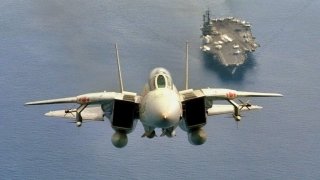The F-14 Tomcat Fighter Never Had a Real Enemy to Fight
The F-14 Tomcat, immortalized by the 1986 film "Top Gun," was a key naval interceptor for the U.S. Navy, designed primarily to establish air superiority and defend against Soviet bombers. First flown in 1970 and operational by 1974 on the USS Enterprise, it replaced the F-4 Phantom.
Summary: The F-14 Tomcat, immortalized by the 1986 film "Top Gun," was a key naval interceptor for the U.S. Navy, designed primarily to establish air superiority and defend against Soviet bombers. First flown in 1970 and operational by 1974 on the USS Enterprise, it replaced the F-4 Phantom.
-Equipped with two Pratt & Whitney TF30-P-412A engines initially, the Tomcat could reach speeds over Mach 2, although engine issues led to several crashes and a later upgrade to General Electric F110-GE-400s.
-Armed with a mix of AIM-7 Sparrow, AIM-9 Sidewinder, and AIM-54 Phoenix missiles, the F-14 had advanced radar capabilities allowing engagements from up to sixty miles away. Despite its capabilities, the F-14 was retired in 2006 due to changing military needs post-Cold War, with only Iran still operating some of these aircraft today.
The F-14 Tomcat: From 'Top Gun' Fame to Historical Naval Icon
If there is a combat plane made popular by a movie, it has to be the F-14 Tomcat.
Top Gun, starring a young Tom Cruise, debuted in 1986. The Navy allowed Hollywood to shoot the movie onboard one of its aircraft carriers in the middle of a deployment. Following the shenanigans of a team of naval aviators, Top Gun was a huge recruitment boost for the Navy.
But what really stole attention was the sleek F-14 Tomcat.
The Navy’s Tomcat
Manufactured by Northrup Grumman, the F-14 Tomcat was a carrier-based naval interceptor. The goal of F-14 Tomcats was to establish air superiority over the battlefield and open the way for ground and naval operations. It was also meant as the first line of defense against Soviet bombers attacking the American aircraft carrier fleet.
The F-14 Tomcat fighter jet first took flight in 1970 and debuted with the fleet in 1974 onboard the USS Enterprise. The aircraft replaced another legendary fighter jet, the F-4 Phantom.
In terms of performance, the aircraft was powered by two powerful Pratt & Whitney TF30-P-412A engines, each of which could produce almost 21,000 lbs of thrust for a combined power of 42,000 lbs. This power made the F-14 Tomcat fast—indeed, it was quite swift, even by today’s standards. The naval interceptor could reach speeds of over Mach 2 (approximately 1,600 miles per hour) and had a range of 2,400 miles.
However, the fighter jet’s powerful Pratt & Whitney engines caused significant trouble. The TF30 engines were plagued with problems, and the Navy estimates that they caused as many as 40 F-14 Tomcats to crash. The Navy and Northrup Grumman eventually realized that the engines were dangerous and replaced them with the General Electric F110-GE-400s.
When it came to weaponry, the F-14 Tomcat could carry either four AIM-7 Sparrow air-to-air missiles and four AIM-9 Sidewinder heat-seeking air-to-air missiles or six AIM-54 Phoenix radar-guided, long-range missiles and two AIM-9 Sidewinders. The powerful AN/AWG-9 radar/missile-control system could engage several enemy aircraft at the same time and allow the F-14 Tomcat to engage enemy aircraft up to sixty miles away.
The naval interceptor could fold its wings, making it more maneuverable and also easier to fit in an aircraft carrier.
The F-14 Tomcat is still in service with an unlikely country: Iran. The Shah’s government purchased several aircraft before the Islamic Revolution in 1979, and a few are still operational.
A Fighter Jet Without a Foe
In the end, the Navy retired the F-14 Tomcat in 2006, relatively sooner than most expected. The rationale among the corridors of the Pentagon was that with the Cold War over and the U.S. military embroiled in counterterrorism and counterinsurgency campaigns in the Middle East, the Navy couldn’t afford to maintain a highly capable but expensive air superiority fighter jet like the F-14 Tomcat. Put simply, the F-14 Tomcat didn’t have an enemy to fight against.
Almost twenty years after its retirement, the F-14 Tomcat is still held as one of the most beautiful and capable fighter jets ever to fly the skies.
About the Author:
Stavros Atlamazoglou is a seasoned defense journalist specializing in special operations and a Hellenic Army veteran (national service with the 575th Marine Battalion and Army HQ). He holds a BA from Johns Hopkins University and an MA from the Johns Hopkins School of Advanced International Studies (SAIS). His work has been featured in Business Insider, Sandboxx, and SOFREP.
Image: Shutterstock.


